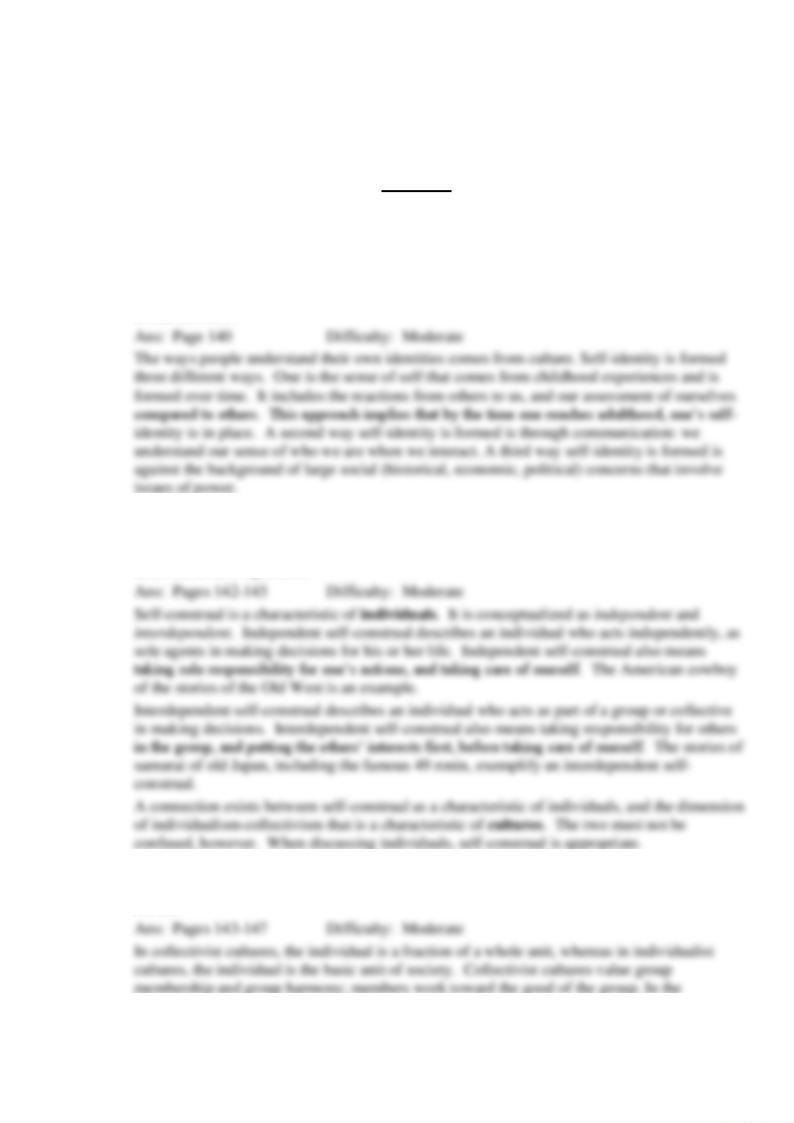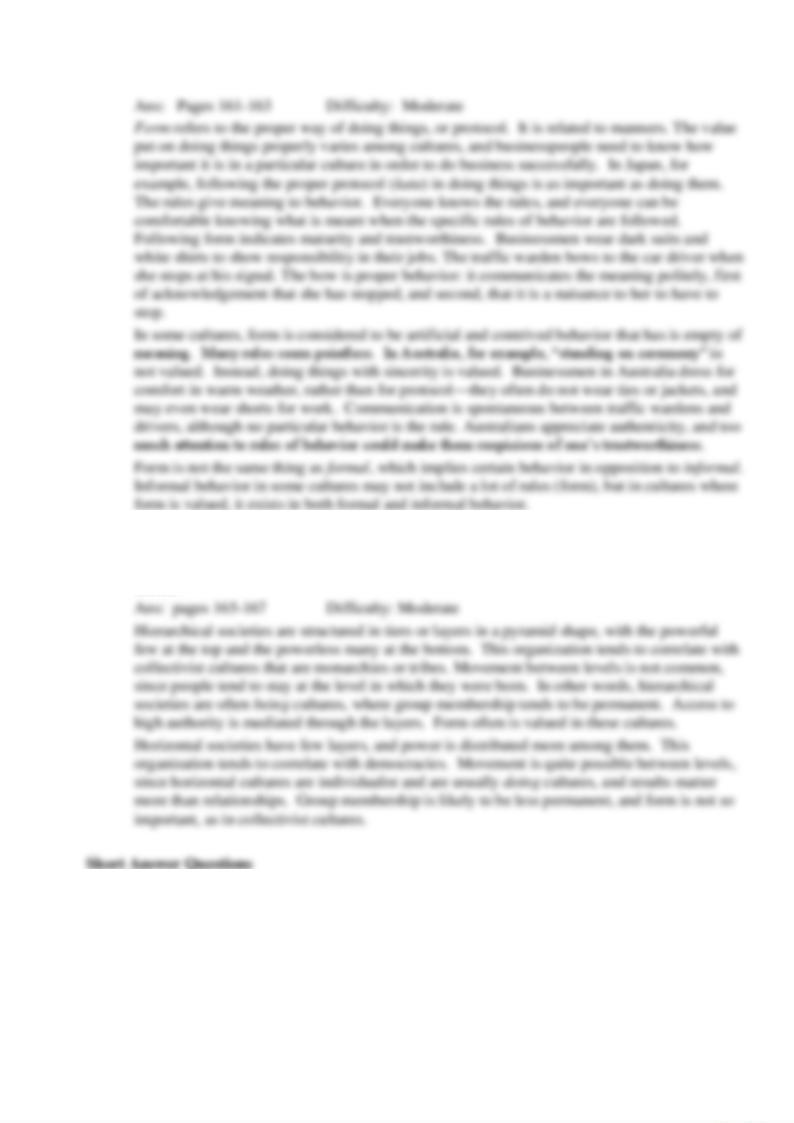
CHAPTER 4
THE SELF AND CROUPS
Test Bank
Essay Questions
1. Discuss self-identity and explain why it is important in investigating culture’s influence on
communication.
2. Self-construal is one important research area that enables us to compare cultures, especially
European/American and Asian cultures. Discuss self-construal and show its relevance to
cross-cultural comparisons.
3. Discuss the cultural dimension of individualism-collectivism in relation to two cultures of your
choice.

workplace, employees feel loyalty to their work group and cooperation is expected.
4. Being indebted or obligated to someone for favors is valued differently in different cultures.
Discuss, using specific examples from two cultures.
5. Discuss the value of age/seniority and attitudes toward age in two cultures. Use specific
examples.
6.. Discuss being female in two different cultures of your choice. Focus your discussion on
women’s roles: traditional and non-traditional. Avoid evaluations of cultures in your answer.

Women’s roles in non-traditional cultures are often a combination of women’s and men’s
7. Collectivist cultures see group membership as permanent, while individualist cultures see
group membership as potentially temporary. Discusses the implications of temporary versus
permanent group membership upon communication with regard to a) face, b) emotion, and c)
shame or guilt.
8. Why is form an important issue in intercultural communication? Use two cultures to give
examples.

9. Societies may prefer a hierarchical organization or a horizontal organization, depending on
culture. Discuss these two structures in relation to two other cultural dimensions of your
choice.
10. Robyn Cameron is about to depart for Thailand on a business trip. She has asked for your help
to prepare her. What do you think she should learn before she leaves? You tell her that Thais
value harmony very much in daily exchanges. She knows only three other facts about
Thailand: 1) it is a monarchy and the king and his family are greatly loved, 2) the majority of
Thais are Buddhist and all men must serve two years as monks, 3) the military enjoys high

status and power. You believe Robyn can learn what she needs to know by answering the
following questions based on inferences from these facts, sometimes called the "3 Ms" of
Thailand. Remember to give your answers based on what Robyn knows.
Answers Chapters 3 and 4 Difficulty: Moderate
a. collectivist, because most people share the same religion (Buddhism), the monarchy is
loved by most, and the military is popular: these are all group/relationship oriented
b. hierarchical; royalty means social hierarchy, as does the military
c. form will likely be trusted and valued; protocol is important for royalty and for the
military
d. permanent; the 3 Ms are all enduring memberships
e. uncertainty will probably be avoided, because the 3 Ms are social institutions that
control uncertainty
f. resist change; the 3 Ms are established institutions
g. yes; the 3Ms are all male-dominated (monks are rendered unclean if a woman touches
them even accidentally; the military is male ; the monarch is male)
h. indirect and implicit; the first answer established the culture is collectivist and Thais are
known for their emphasis on harmony, so too-direct speech could threaten the harmony
they value
i. books; Thais are Buddhists which is based on holy texts, and students learn from texts.
(At the same time, some sects of Buddhism emphasize meditation, which could be
interpreted as personal experience that is the most valued source of learning.)

j. mastering received wisdom; in the monasteries, at the royal court, and in the military
asking questions is not encouraged.
k. age is valued; seniority matters to royalty and the nobility, and it matters in the military
as well as in the monasteries
l. mediated; the 3Ms all practice mediated approaches to authority
m. relationships; having connections to the royal family is important in a hierarchical
society, and connections are also important in the military and the monastery
n. obligation is a benefit and a potential for a favor being returned one day; the first
answer established the society is collectivist, and the previous answer established it is
relationship-oriented, and group memberships tend to be permanent
[These questions about Thai culture are an opportunity for students to relate cultural dimensions into
an integrated understanding of the culture]
True-False Questions
11. Culture shapes self-identity.
12. One way to understand identity is as something formed partly by the self and partly by group
membership.
13. Self-construal is either interdependent or co-dependent
14. Independent self-construal tends to appear in collectivist cultures.
15. Interdependent self-construal is the same thing as collectivism.
16. The individual is the basic unit of society in all cultures.
17. The Japanese expression, “The nail that sticks up will be pounded down” indicates that culture
is collectivist.
18. Collectivist cultures value cooperation and, correspondingly, individualist cultures value
competition.

19. In many cultures relationships mean obligations--being asked and asking for favors.
20. In some cultures, to pay back a favor to clear the indebtedness is to terminate the relationship.
21. Seniority is valued in cultures that give old people great freedom from responsibility.
22. The way women are viewed in different cultures can partly be understood by looking at their
roles.
23. Muslim cultures are among those in the world that do not value women.
24. Women in every culture want to be considered equal to men
25. Throughout the world, women do not achieve key business positions in equal numbers with
men.
27. It is unimportant to business people whether or not members of a culture feel comfortable
28. It is possible for foreigners to cause shame to members of "shame cultures" without even
realizing it.
29. Form means rules of etiquette and manners while interacting with others for business purposes.

Multiple Choice Questions
31. Three ways of explaining the development of self-identity are
a. social-psychological, communication, and critical approaches
b. intercultural, critical, and international approaches
c. social-psychological, intercultural, and critical approaches
d. social-psychological, intercultural, and critical approaches
32. Self-construal is
a. the same as self-motivation
b. only relevant to Western cultures
c. the way we see ourselves in relation to others
d. the way we see ourselves without reference to others
33. Interdependent self-construal
a. is the same as individualism
b. is the same as collectivism
c. is a structured notion of self as independent
d. is a structured notion of self as connected to others
34. The individual
a. is the basic unit of society in individualist cultures
b. is the starting point for decisions in collectivist cultures
c. is important in cultures that value interdependence
d. is important in cultures that can be called collectivist
35. The interpretation of obligation as a cultural dimension involves
a. cultural values concerning the environment
b. cultural values concerning achievement of results and group membership
c. the ability of the more affluent party to wait for repayment
d. the rules established by the poorer party
36. In cultures that view group membership as permanent
a. the culture of the group values low-context, explicit communication
b. the members of the group are all about the same age

c. the culture of the group values individual achievement of measurable results
d. responsibilities to other members come before personal rights
37. Displaying the emotion of anger in business meetings
a. is typical of cultures that value group relationships
b. is often practiced by members of high-context cultures
c. is downplayed in group-oriented cultures because it could threaten harmony
d. is stressed in group-oriented cultures because it is a typical activity of collectivist
cultures
38. Shame
a. is the same thing as guilt: an emotion of embarrassment
b. is the same thing as losing face: a failure to meet others' expectations
c. operates to motivate behavior in individualistic cultures
d. operates to motivate behavior in collectivist cultures
39. Form
a. is highly valued as a key cultural priority in the United States
b. operates to some degree in every culture, but is a low priority in Japan
c. is trusted in cultures that value "correct" behavior as a way to prevent loss of face
d. is trusted in cultures that value spontaneity as evidence of sincerity and openness
40. Hierarchy in a social organization
a. is present to a greater or lesser degree in almost all cultures
b. is least likely to exist in a society that is ruled by a king
c. is the opposite pattern of social structure from Confucianism or Hinduism